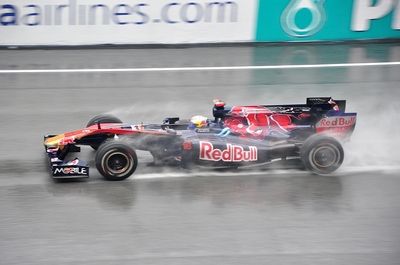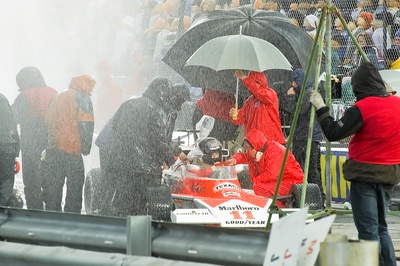 Whether you are enjoying a mountain hike, a trip to the beach or perhaps even a weekend barbeque, there are a lot of things that rain has a significant impact on.
Whether you are enjoying a mountain hike, a trip to the beach or perhaps even a weekend barbeque, there are a lot of things that rain has a significant impact on.
It is for this reason that so many of us make sure we check the weather forecast virtually every single day, so we can be prepared for what is likely to come. It is not just our leisure pursuits that rain effects though, across many sports the weather can big say as to how a race or match turns out.
Formula 1 is a prime example of this as rainfall can very easily ruin a driver’s race or provide a rare podium finish for another. As such, you will find teams closely monitoring the weather on a regular basis so they are able to react accordingly.
In this article, we will explore exactly why rain makes such a big difference in Formula 1 and the impact it has on betting markets.
Why Is Rain Such A Big Deal in F1?
 There are two main reasons why a wet track during an F1 race or qualification session is of such significance. The first is the reduced grip on the track. This is a problem teams can be partly alleviated by driving with appropriate tyres, such as ‘full wet’ tyres as these can displace 85 litres of water per second when driving at 300km/h. The displacement is crucial as non-displaced water can easily lead to hydroplaning as the rubber tyre ends up making contact with water rather than the ground. While such wet tyres help provide much more grip in wet conditions than a slick tyre would, drivers still lack the same kind of traction they would get on a dry circuit (with slicks). This makes incidents such as drivers spinning out or locking their breaks much more likely.
There are two main reasons why a wet track during an F1 race or qualification session is of such significance. The first is the reduced grip on the track. This is a problem teams can be partly alleviated by driving with appropriate tyres, such as ‘full wet’ tyres as these can displace 85 litres of water per second when driving at 300km/h. The displacement is crucial as non-displaced water can easily lead to hydroplaning as the rubber tyre ends up making contact with water rather than the ground. While such wet tyres help provide much more grip in wet conditions than a slick tyre would, drivers still lack the same kind of traction they would get on a dry circuit (with slicks). This makes incidents such as drivers spinning out or locking their breaks much more likely.
The other reason the rain matters is the reduced visibility due to the sheer amount of spray that F1 cars push out behind them. In a dry event, drivers will often tail one another, mainly because they want to stick to the racing line but also because they get the benefits of slipstreaming. Tailing a driver becomes much more difficult though when a shower is being sprayed, non-stop, onto your visor. It has been a problem that has been exacerbated since 2017 as starting from that year rule adjustments made cars faster and also gave them a tyre width increase of 25%. This saw an extra increase in the amount of spray the cars produce on a wet track.
You do not have to just take our word for it though. The F1 produced a video where drivers talk about the challenges they face driving in the rain and how difficult it can be. Esteban Ocon sums it up well when he says, “If you close your eyes or keep them open, you do not see anything”. During the wettest of races, this is barely even an exaggeration as it is just a struggle to make it to the end of the race, let alone pull off any smart overtaking moves.
What Changes Are Made To Cars When It Rains?
 For a dry race, all F1 drivers are required to race using any two dry compound tyres. This rule does not apply however if the FIA declares a race ‘wet’, in which case drivers will instead choose an intermediate set of tyres or full wets. The former is the most versatile option and will be used on a wet track that lacks standing water, or a track that is drying out. The choice is up to the team unless rainfall is so heavy that the safety car is required to begin the race, in such cases full wets are needed. They can however be changed whenever a car makes a pit stop.
For a dry race, all F1 drivers are required to race using any two dry compound tyres. This rule does not apply however if the FIA declares a race ‘wet’, in which case drivers will instead choose an intermediate set of tyres or full wets. The former is the most versatile option and will be used on a wet track that lacks standing water, or a track that is drying out. The choice is up to the team unless rainfall is so heavy that the safety car is required to begin the race, in such cases full wets are needed. They can however be changed whenever a car makes a pit stop.
This is by far the most significant change that occurs during rainy conditions but it is by no means the only one. In terms of car modifications, teams may look to make adjustments to the car to increase the downforce generated by the front wing by adjusting the angle. This is really the only bodywork modification that can take place once parc fermé has begun (i.e. the time after qualification during which cars must be positioned in the paddock that is sectioned off by the F1 authorities). The rules can be relaxed a little though when conditions go from dry to wet (and is declared as a ‘change in climatic conditions’) between qualification and the race start. Should this occur, teams are permitted to make a few more changes. What you will find though is that some teams make changes pre-parc fermé as to their best guess of what the weather will be like on the day of the race.
If a wet race seems likely, a team may choose to increase the ride height, as this is likely to make life easier for the driver. If it turns out though that their prediction of rain was completely off the mark, they can revert back to a dry race set-up. This will come at the penalty of starting from the pit lane though, assuming the changes were not allowed under parc fermé rules. In some instances, this can be seen as a price worth paying. To give you one example, ahead of an incredibly wet 2021 Belgian Grand Prix, Alfa Romeo made changes to the rear wing assembly of Kimi Raikkonen’s car so he could deal better with the conditions. The previous set-up saw him qualify with the second-slowest time and half a second behind 17th place, so without the change he would have stood no chance.
As it was, the race itself was rained-off but had the rain not been so torrential at Spa, Raikkonen would have ended up being much more competitive.
How Is Driving Different In The Rain?
 It is fair to say that drivers will need to be even less fearless than normal when speeding across the track in wet conditions.
It is fair to say that drivers will need to be even less fearless than normal when speeding across the track in wet conditions.
This fearlessness relates to attitude rather than driving style though as pushing the car to the limits in the wet will likely result in a car spinning out of control.
To survive on a less grippy surface, drivers will need to accelerate out of corners less explosively, ‘feathering’ their throttle a little more.
Similarly, they will need to brake into corners earlier as slamming the pedal too sharply may cause the wheels to lock up.
Drivers will also likely deviate from the standard racing line as the rubber embedded on this line becomes especially slippery when wet and the same is true of many kerbs.
How Does Rain Impact F1 Betting?

Much like how some drivers excel on certain circuits, some drivers relish the rain far more than others. From the more recent crop of drivers, Lewis Hamilton has consistently demonstrated an extremely high pedigree when racing in wet conditions. With newer drivers, a limited data set makes it harder to judge but you can form an idea by taking a look at any wet Grand Prix over the previous year or two. It is quite possible that rainy conditions will cause the odds to shift a little, thanks to these differences in wet-weather abilities. If not, you may find you are effectively getting better value for money on your selection.
Now, qualification times always shape race odds but in a wet qualifying session, a bad time is not always a major cause for concern. Say for instance one driver has a horrid time in qualification and ends up third from last, their worst performance so far that season. It could well be that this poor showing was due to their car not being optimised for the conditions. If adjustments can be made (even if it means starting from the pit lane) or if the forecast for the race itself is dry, then the driver may end performing much better during the race itself.
Rain and In-Play F1 Betting
If heavy rain begins to fall mid-race, this can easily impact the in-play odds. Imagine a situation in which the leading driver has pitted and then five laps later the heavens open up, unexpectedly. This driver will need to head into the pits again to change their tyres, meaning they’ve lost a considerable amount of time through pitting. For the drivers that held off taking a pit-stop, they can just head in once and there is no obligation to swap tyres twice as there would be in a dry race.
The pit/tyre strategy teams adopt can end up working heavily in, or against their favour. The earlier that you, as a bettor, spot which way an approach is going to head, the sooner you can place a bet at better odds. The 2019 German Grand Prix is a good example of this as Mercedes refused to take a chance on the weather improving and kept Hamilton on intermediates for too long. With hindsight, Mercedes’ trackside operations director Andrew Shovlin admitted adopting Lance Stroll’s approach, coming in for slicks much earlier, was the right thing to do. Despite starting in 15th place, this early swap of tyres enabled saw Stroll finish in fourth place, comfortably his best finish of the entire season.
F1 Upsets In The Rain
Finally, we would just mention that surprise results are more likely to happen in wet conditions and this applies to both the race and qualifying. For example, across the entire 2020 season, only two GPs failed to see either Lewis Hamilton or Valtteri Bottas (both Mercedes) qualify in pole position. One exception was in Abu Dhabi, which Max Verstappen topped and the other was during a very slippery and damp Turkish GP in which Lance Stroll comfortably recorded the best qualifying time. In the case of the latter, this was Stroll’s first-ever career F1 pole and only the second time in the entire season he qualified within the top four.
